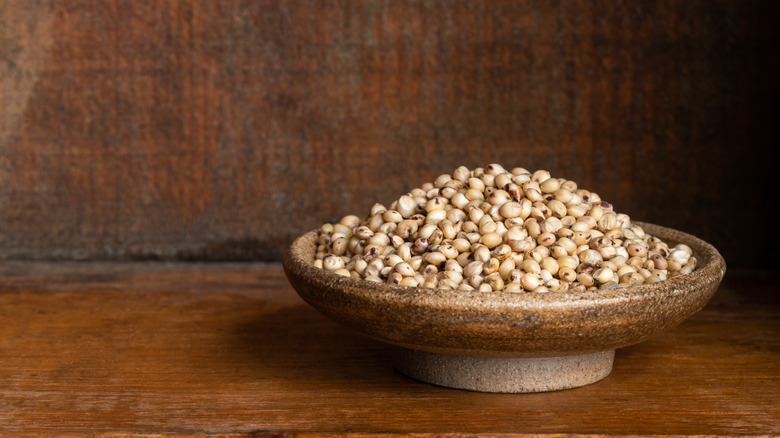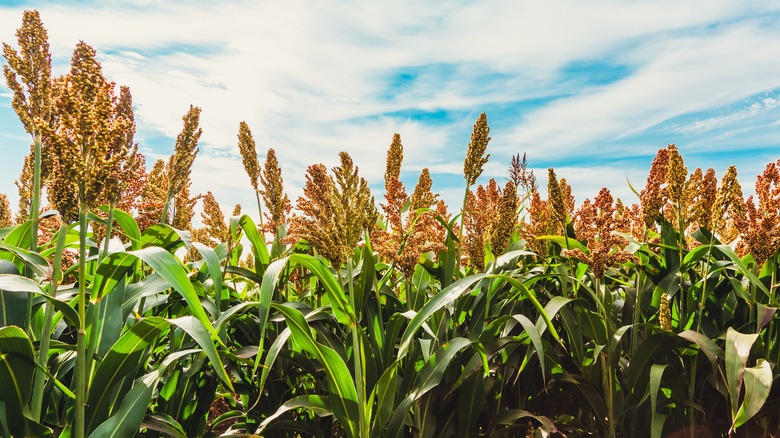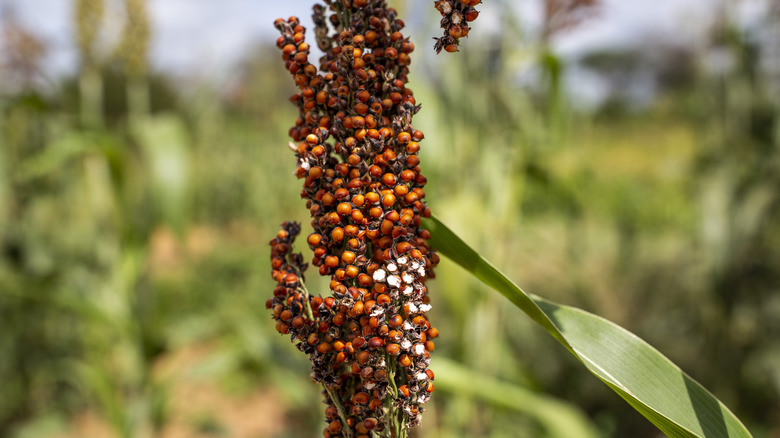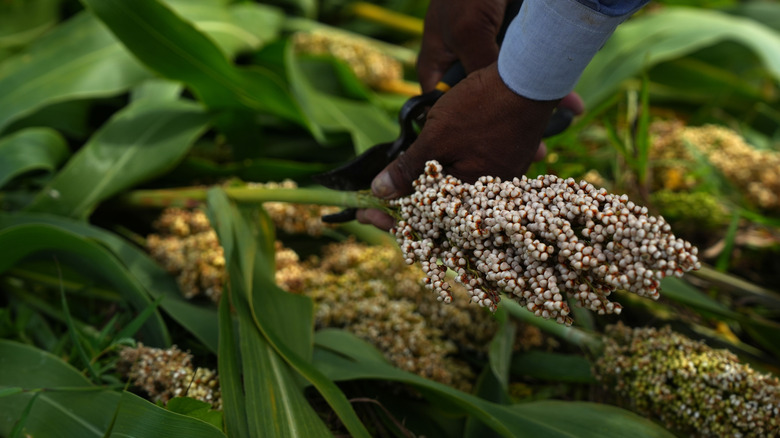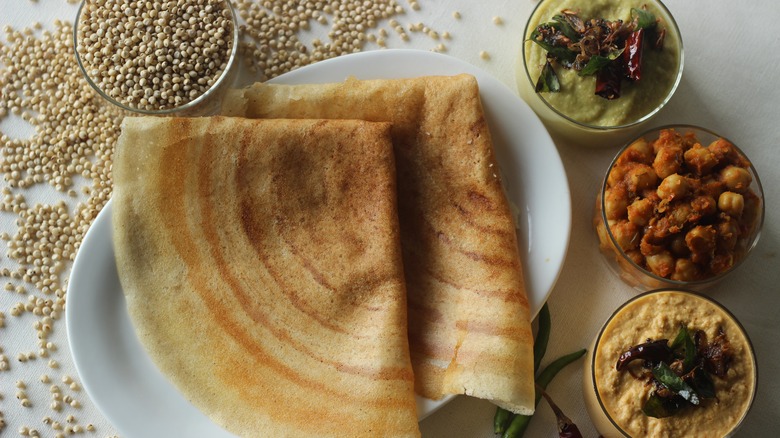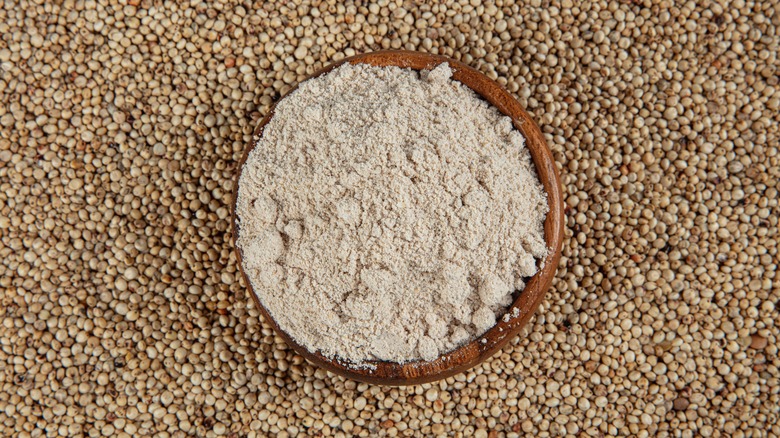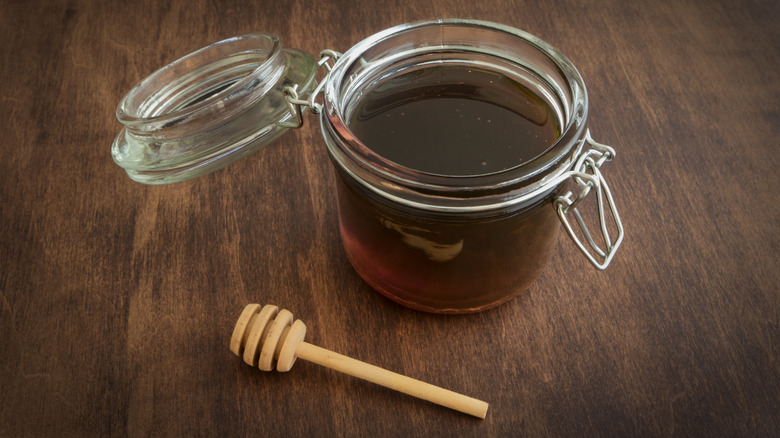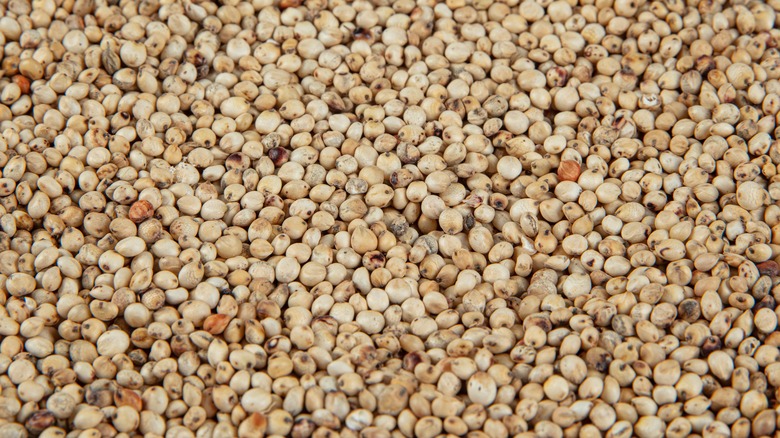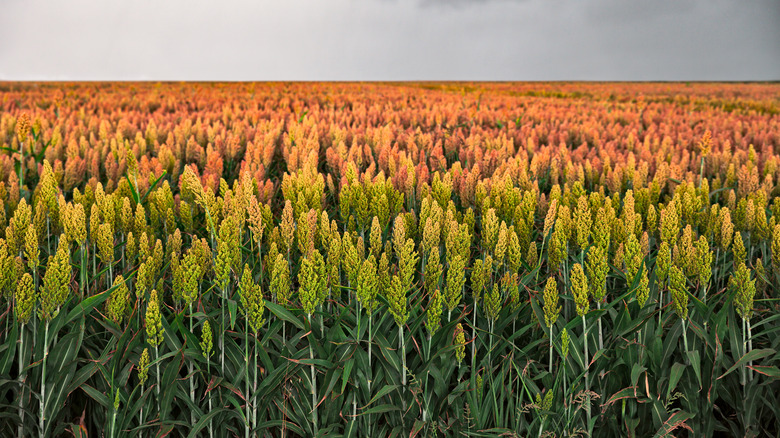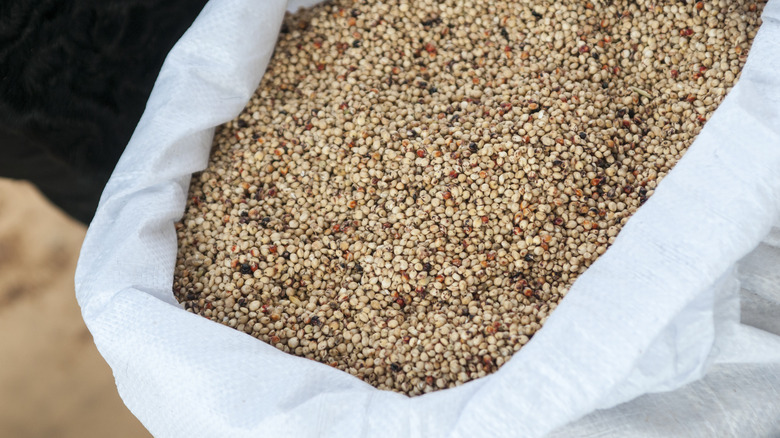What Is Sorghum And Where Does It Come From?
An underrated ancient grain, sorghum is a versatile, up-and-coming powerhouse ingredient in the kitchen. Forbes currently ranks it 5th in overall global grain production, though a large percentage of this is currently harvested for animal agriculture and not necessarily human consumption; it remains somewhat of a mystery as to why sorghum has been a long-standing staple in some cultures while in others it has remained largely overlooked. Misconceptions about the grain's nutrient content have veiled the fact that sorghum is actually a highly nutrient-dense agricultural product that's also drought-resistant, requiring much less irrigation than other more conventional grains, and making sorghum inherently more ecologically sound to grow.
Able to withstand tougher climates than wheat or corn, while being more nutritious than either, sorghum is easy to incorporate into a diverse array of diets because it's a non-GMO grain that's naturally gluten-free. Sorghum stalks can also be cultivated for a variety of purposes, from edible sorghum syrup to sustainable biofuel. There are all kinds of reasons why sorghum is worth adding to your diet if you haven't tried it already.
What is sorghum?
Sorghum is an ancient cereal grain grown worldwide, but it may fall under the radar because it goes by many names — for example, it's also commonly known as milo. Black, purple, red, brown, yellow, or white sorghum seeds comprise a versatile cereal that grows from tall stalks resembling corn, and sorghum stalks are harvested for consumption nearly as often as their seeds. Officially categorized as a grass, and capable of growing quite tall, sorghum is harvested in some parts of the world mostly for animal fodder, while in other regions it's cultivated primarily for people to eat.
Sorghum seeds can be cooked, popped, flaked, milled, boiled, fermented, and brewed, and their many edible forms are accompanied by equally numerous names. In Africa, sorghum seeds might be called durra or Guinea corn, and are often served as a porridge or fermented into beer. In India, sorghum grains are called cholam, jonna, or jowar and are ground to produce traditional flatbreads. In China, they go by the name kaoliang, synonymous with the strong baijiu liquor made from fermented sorghum. The reason sorghum seeds are rising in popularity the world over, however, is because, in their truest form, they are a significant source of plant protein that's naturally gluten-free.
Where does sorghum come from?
Sorghum cultivation can be traced back to Northern Africa as early as 8000 B.C., where it remains the continent's second most largely produced cereal grain today. As one of many ancient grains receiving attention, the sorghum plant remains more or less unchanged from what it was thousands of years ago. It thrives in arid climates, which is why it found early agricultural success in Africa, with its dramatically variable rainfall, before migrating to India and China.
Later, with increased access to international trade, sorghum was also successfully cultivated in the Great Plains of the Americas and Australia. Benjamin Franklin is credited with the first known record of sorghum in the United States, and even then the crop was recognized for its versatility. "I inclose you some of the Grain called Whisk Corn, or Broom Corn," he wrote to Samuel Ward in 1757, in a letter from the National Archives. "It must be planted in Hills like Indian Corn, 3 or 4 Grains in a Hill. It looks like Indian Corn when growing, till the Top comes out, of which they make the Whisk Brushes for Velvet, and excellent Brooms. The Grain is good for Bread, and for Fowls, Horses, &c. being a kind of Millet, and of great Increase." Today, broomcorn has come to define a variety of sorghum that is still harvested to make stiff bristles for brooms and brushes, and the United States has become the leading producer of sorghum worldwide.
How is it harvested?
Sorghum is harvested in late summer or early fall in a variety of ways, depending on where in the world it is cultivated. In the U.S., sorghum is harvested on an industrial scale, where grain headers — machines that collect only plant heads and not the stalks — gather sorghum grain heads all at once. In other parts of the world, sorghum is grown on much smaller farms. In Africa and India it is still largely harvested by hand–threshing with sticks or sickles.
No matter which method of harvesting, sorghum grains must be dried after they're gathered. Once ready, and if not being milled into flour, there are two main forms of sorghum grains packaged for consumption — whole grain and pearled sorghum. Whole grain refers to sorghum grains that are left intact, making these grains full of flavor and nutrients. Pearled sorghum refers to grains that have had the outside hull removed. This discards some nutrients but it also gives the grains a milder flavor that doesn't overpower any dishes they're added to.
What does it taste like?
Sorghum has an earthy taste and al dente texture somewhere between barley and brown rice, which is more intense in whole grain than pearled varieties. There is a certain nuttiness to sorghum grains' natural flavor which pairs equally well with sweet and savory dishes. "It tastes like the ancient grain that it is," New York Chef Mark Forgione told The Herald News. "It's got a great bite to it. It's very earthy ... it has a nice chew to it, a full texture."
The syrup that can also be made from sorghum, however, has a flavor that does not reflect the subtlety of the grain that comes from the same plant. Though lower in sugar content than other similar sweeteners such as molasses, sorghum syrup is intensely sweet. But this sweetness is mingled with a complex flavor profile that twists and turns into notes of slight sourness and at times even bitterness. Sorghum syrup is distinct amongst other liquid sweeteners, with more of a bite than the more familiar tastes of honey or maple syrup. It may be a slightly acquired taste, but adds a unique dimension to cooking, whether mixed into a recipe or served as a garnish. "Its texture is smooth and thick," Elise Smith, founder of WinniE's Bakery in Columbia, Maryland, explained for Southern Living, "although more fluid in consistency than traditional molasses, with a light and smoky mouth feel."
Sorghum flour
Sorghum flour, with its mild and slightly sweet flavor, has long been used to make traditional flatbreads across the globe, from India's jowar roti, an unleavened naan, to Central American tortillas, to Korean fried sorghum pancakes called susu bukkumi. In other parts of the world, sorghum flour is starting to rise in popularity and has proven to be an effective gluten-free substitute for all manner of baking.
In terms of flavor, sorghum flour is considered to be most similar to wheat flour, and can easily be substituted for wheat flour too. Sorghum flour substitutions in most recipes work at a regular 1:1 ratio, and sorghum flour is commonly found in pre-made gluten-free all-purpose flour blends. But because sorghum flour is gluten-free, it lacks the same structure as wheat flour, which is why it's traditionally best suited to flatbreads. If used in other forms of baking, sorghum flour requires the help of a binding agent to give finished baked goods which have a proper rise and consistency. Adding an additional binder such as xantham gum, guar gum, or psyllium husk will ensure that baked goods made with sorghum flour achieve the desired result.
Sorghum syrup
While sorghum seeds can be enjoyed in a diverse selection of forms and cooking methods, other parts of the sorghum plant are cultivated too. Sorghum syrup, also known as sorghum molasses or sweet sorghum, comes from the juice of sorghum stalks which refines down to a thick syrup through the same process that creates molasses from sugar cane. Today, sorghum syrup makes a decent substitute for molasses, and is most commonly included as a sweetener in mass-produced processed foods. But it was once the most predominant sweetener used in American households.
In the early days of American history, sweeteners were a luxury hard to come by. Sugar, especially, was an expensive commodity during colonial times. On the other hand, sorghum syrup — squeezed from the juice of the sorghum plant that early American settlers were already harvesting for different purposes — was much more accessible than sugar or molasses, and possibly even sweeter. Though cane sugar replaced other sweeteners in the 19th century, due to the slave trade lowering production costs, sorghum made a comeback during the Civil War because the conflict put sugar in short supply once again. Another surge in sorghum syrup production came in the early 20th century, when it was used as an essential ingredient in the production of prohibition-era moonshine. Sorghum syrup has continued to be a tradition in the South to this day, with a beloved and nostalgia-inducing flavor, but this distinctive syrup is not well known outside of this region.
How to cook with sorghum
Beyond its incarnations as syrup or flour which pair well with sweet flavor profiles and are well-suited to baking, sorghum grains themselves can take on many forms and textures when cooked. Sorghum is simple enough to prepare — the grains simply need to be boiled in water. Though sorghum takes longer to cook than other grains, requiring around one hour to achieve the desired consistency, it's a relatively hands-off grain to prepare. When cooked, sorghum functions as an apt substitution for rice or quinoa, making for a nutrient-dense side dish, salad base, or topping, and an ingredient that adds heartiness to soups and stews. If cooked down even further, sorghum can also be enjoyed as a porridge, as it is commonly consumed in Africa.
But sorghum grains can also be enjoyed uncooked in the form of popped sorghum — over heat, these grains pop just as well as popcorn. Though the popped kernels may be rather smaller, their taste has a little more of an earthy kick.
Sorghum nutritional information
Sorghum grains are a source of complex carbohydrates full of nutrients, containing high amounts of protein, fiber, and antioxidants. Among the many different varieties of sorghum grown worldwide, black sorghum is known to be especially full of health benefits, as its dark color comes from a high concentration of antioxidants called anthocyanins.
According to the United States Department of Agriculture's FoodData Central, one cup of sorghum can contain as many as 20 grams of protein, placing it on a similar nutritional standing with quinoa. One study, published in the Journal of the Science of Food and Agriculture, found sorghum to be a low-glycemic grain, which means it doesn't spike blood sugar levels the same way as other starch products like wheat or rice. This makes sorghum a possible option for people trying to limit their sugar intake. It's also a source of B vitamins and magnesium, which contribute to immune health and disease prevention. While inherently full of nutrients, sorghum is also notable for the fact that it is a non-GMO grain that's gluten-free, and consequently a healthy choice for anyone looking to expand their dietary horizons.
Sustainability benefits
A study published in the journal Foods notes, "The production of ancient grains is regarded as being environmentally friendly, generating low carbon footprints as they require less irrigation, pesticides and fertilizers compared to many normal grains." Sorghum, in particular, has proven to be a plant that's more sustainable to produce than many other grains which use up more resources. Sorghum, which thrives in arid climates, is both drought and heat-resistant and so doesn't require an exorbitant amount of water to grow. In fact, per Kansas Farm Food Connection's stats, growing one bushel of sorghum only requires 6 inches of water, which comes from both soil and rainfall and not just irrigation.
In addition to sorghum's climate resilience, this hardy crop is at the center of research for biofuel and carbon sequestration too. While California-based researchers are developing methods for using sorghum to remove carbon from the atmosphere, other recent studies have also found that sorghum may have additional environmental benefits as a food source for pollinators. "Sorghum is not listed as a plant recommended to homeowners to feed pollinators despite frequent bee sightings," Karen Harris-Shultz, a research geneticist based in Tifton, Georgia explained to the USDA. "However, we found that sorghum had unintended ecological benefits. It can be a potential landscape plant for homeowners and a food source for pollinators during times of pollen and nectar shortage."
Where to buy sorghum
Sorghum grains and flour are sometimes available in big chain grocery stores, most probably in the bulk foods aisle — though it's usually a better guarantee to find sorghum products in health food stores, and they're even more likely to be available in Indian or African grocery stores. Bob's Red Mill is one of the larger mainstream manufactures of sorghum grains, and this brand can be found at many Whole Foods retailers.
Sorghum syrup and flour, on the other hand, may not be quite so readily available as the grains themselves. While the flour is a staple in some cultures around the world, it's not so well-known in the States. The syrup remains popular only regionally, and can be procured at some brick-and-mortar locations in the South. In general, though, sorghum grains, flour, and syrup, while still up-and-coming ingredients, are most reliably found online. Retailers like Amazon and Global Food Hub offer bulk options at reasonable rates.
